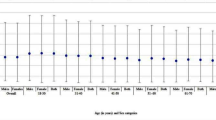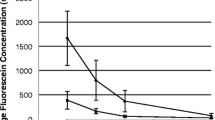Abstract
⊎ Background: The study was carried out to compare corneal endothelial permeability and aqueous flow values of healthy volunteers measured in different countries with identical fluorophotometers using a standardized protocol. ⊎ Method: Healthy volunteers aged between 20 and 70 years were studied in five European cities. Fluorescence scans of the anterior segment of both eyes were made using a commercial fluorophotometer. Beginning 4 h after instillation of four drops of fluorescein 10%, 12 scans of the anterior segment of each eye were performed in 2 h. The values of corneal endothelial permeability and aqueous flow were calculated with standardized software from the decay of the fluorescein concentration in the cornea and anterior chamber. Results: The mean permeability values (× 10−4 cm·min−1)±SD were 3.7-1.6 (n=19; Coimbra, Portugal), 4.3-1.1 (n=19; Frankfurt, Germany), 3.9±0.9 (n=19; Leiden, The Netherlands) and 5.4±1.2 (n=10; Milan, Italy). The values were not significantly different (ANOVA, P>0.3), except those in Milan. The mean flow values (μl·min−1) ±SD were 2.3±0.9 (n=17; Coimbra), 1.9±0.7 (n=10; Cologne, Germany), 2.6±1.2 (n=19; Frankfurt), 2.0±0.6 (n=19; Leiden) and 1.7±0.8 (n=10; Milan). The values were not significantly different (Kruskal-Wallis test, P>0.1). ⊎ Conclusions: Permeability and flow values in the different cities had similar values and standard deviations. The Concerted Action demonstrated the usefulness of a standardized protocol.
Similar content being viewed by others
References
Araie M (1983) Kinetics of intraocular penetration of topical fluorescein: analysis by new method. Jpn J Ophthalmol 27:421–433
Best JA van, Kappelhof JP, Laterveer L, Oosterhuis JA (1987) Blood aqueous barrier permeability versus age by fluorophotometry. Curr Eye Res 6:855–863
Bloom JN, Levene RZ, Thomas G, Kimura R (1976) Fluorophotometry and the rate of aqueous flow in man. Arch Ophthalmol 94:435–443
Boets EPM (1995) Fluorophotometry of the anterior segment of the eye with special attention to contact lenses. Thesis, State University of Leiden, The Netherlands
Bourne WM, Nagataki S, Brubaker RF (1984) The permeability of the corneal endothelium to fluorescein in the normal human eye. Curr Eye Res 3:509–513
Brubaker RF, Nagataki S, Townsend DJ, Burns RR, Higgins RG, Wentworth W (1981) The effect of age on aqueous humor formation in man. Ophthalmology 88:283–287
Brubaker RF (1991) Flow of aqueous humor in humans. Invest Ophthalmol Vis Sci 32:3145–3166
Brubaker RF (1993) Clinical evaluation of the circulation of aqueous humour. In: Tasman W, Jaeger EA (eds) Duane's clinical ophthalmology, vol 3, revised edn. Lippincott, Philadelphia, pp 1–11
Carlson KH, Bourne WM, Brubaker RF (1988) Effect of long-term contact lens wear on corneal endothelial cell morphology and function. Invest Ophthalmol Vis Sci 29:185–193
Coakes RL, Brubaker RF (1979) Method of measuring aqueous humor flow and corneal endothelial permeability using a fluorophotometry nomogram. Invest Ophthalmol Vis Sci 18:288–302
Cotlier E (1987) The lens. In: Moses RA, Hart WM Jr (eds) Adler's physiology of the eye: clinical application, 8th edn. Mosby, St. Louis, pp 268–290
Coulangeon LM, Menerath JM, Sole P (1987) Fluorophotometry by topical administration. I. Aqueous humor flow and corneal endothelial permeability. J Fr Opbthalmol 10:365–373
Coulangeon LM, Sole M, Menerath JM (1990) Aqueous humor flow measured by fluorophotometry. A comparative study of the effect of different beta-blocker eye drops in patients with ocular hypertension. Ophthalmologie 4:156–161
Davson H (ed) (1962) The eye, volume 4, Visual optics and the optical space sense. Academic Press, New York, pp 101–111
Diestelhorst M, Kriegstein GK (1992) Does aqueous humor secretion decrease with age? Int Ophthalmol 16:305–309
Genderen MM van, Best JA van, Oosterhuis JA (1988) The immediate effect of phenylephrine on aqueous flow in man. Invest Ophthalmol Vis Sci 29:1469–1473
Goebbels M, Spitznas M (1991) Endothelial barrier function after phacoemulsification: a comparison between diabetic and non-diabetic patients. Graefes Arch Clin Exp Ophthalmol 229:254–257
Holm O (1968) A photogrammetric method for estimation of the pupillary aqueous flow in the living human eye. Acta Ophthalmol 46:254–283
Jones RF, Maurice DM (1966) New methods of measuring the rate of aqueous flow in man with fluorescein. Exp Eye Res 5:208–220
Kruijf EJFM de, Boot JP, Laterveer L, Best JA van, Ramselaar JAM, Oosterhuis JA (1987) A simple method for determination of corneal epithelial permeability in humans. Curr Eye Res 6:1327–1334
Kuppens EVMJ, Stolwijk TR, Genderen MM van, Keizer RJW de, Best JA van (1995) Corneal endothelial permeability and aqueous humor dynamicsin normal pressure glaucoma. Int Ophthalmol 18:253–257
Olsen T, Ehlers N (1984) The thickness of the human cornea as determined by a specular method. Acta Ophthalmol 62:859–871
Ota Y, Mishima S, Maurice DM (1974) Endothelial permeability of the living cornea to fluorescein. Invest Ophthalmol 13:945–949
Rice SW, Bourne WM, Brubaker RF (1983) Absence of an effect of topical dexamethasone on endothelial permeability and flow of aqueous humor. Invest Ophthalmol Vis Sci 24:1307–1311
Schenker HI, Yablonski ME, Podos SM, Linder L (1981) Fluorophotometric study of epinephrine and timolol in human subjects. Arch Ophthalmol 99:1212–1216
Seto C, Araie M, Sawa M, Takase M (1987) Human corneal endethelial permeability to fluorescein and fluorescein glucuronide. Invest Ophthalmol Vis Sci 28:1457–1463
Topper JE, McLaren J, Brubaker RF (1984) Measurement of aqueous humor flow with scanning ocular fluorophotometers. Curr Eye Res 3:1391–1395
Tsuru M, Araie M, Tanishima T (1985) A fluorophotometric study of the corneal graft: a postoperative follow-up. Graefes Arch Clin Exp Ophthalmol 222:263–265
Zar JH (1984) In: Kurtz B (ed) Biostatistical analysis, 2nd edn. PrenticeHall, Englewood Cliffs, NJ, pp 95–96, 162–201
Author information
Authors and Affiliations
Additional information
Concerted Action supported in part by the European Commission, on ‘Ocular Fluorometry: Standardization and Instrumentation Development’ of the 4th European Community Medical and Health Research Programme (No. MR 4*/0314/P).
Rights and permissions
About this article
Cite this article
van Best, J.A., Diestelhorst, M., Leite, E. et al. Corneal endothelial permeability and aqueous humor flow using a standard protocol. Graefe's Arch Clin Exp Ophthalmol 233, 582–591 (1995). https://doi.org/10.1007/BF00404710
Received:
Revised:
Accepted:
Issue Date:
DOI: https://doi.org/10.1007/BF00404710




